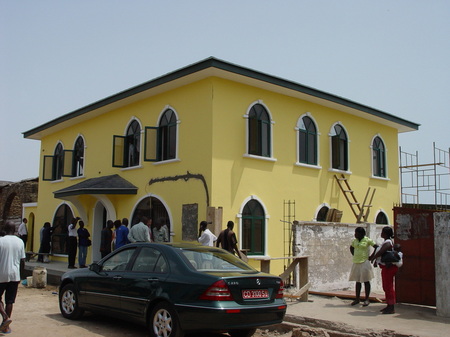Ghana Brazil People
The History of the Brazil House
The History of the Brazil House is closely related to the History of the Tabom People, who returned to Ghana from Brazil in 1836. It is maybe the biggest material symbol of the importance of the Tabom People and a symbol of their History in Ghana. This becomes very clear when we look at its privileged location, in the Brazil Lane in Old Accra, facing the sea, straight in front of the old port, for a long time the gate from and to the world.

When Mamah Nassu arrived together with six other families in 1836 from Brazil, he was the flag bearer of the clan. He bought that land in the Brazil Lane and built a house there for his family. He was married to Naa Supiana and had a daughter called Naa Chercher, who later married a royal from the Nii Oto Din family of Otublohum. This marriage is a clear sign that the Tabom People were welcomed and accepted within the Ga State. Naa Chercher had four children: Okanta Acquah, Kofi Acquah, Florence Acquah and Mary Acquah. Her son Kofi Acquah became a professional cook. He went to Warri in Nigeria and worked there for some years. On his return to the Gold Coast he demolished the old family house built by Nii Mama Nassu and replaced it by the present two storey house as a family house for himself and his sisters.
For a considerable number of years the late Kofi Acquah leased the house to various European businessmen and companies. One of these companies built a warehouse on the land, which they used for their business.

From the year 1942 however the house was no longer rented out and the family went to live there. The warehouse was converted into dwellings and let out to outsiders. A few surviving members who are direct descendants of Kofi Acquah are also living in the house.
The African Contribution to Brazilian Football
To think of Brazilian football without African contribution is virtually impossible. We are the only nation that participated in all the World Championships ever organized and are five times World Champions (1958, 1962, 1970, 1994 and 2002). One of the biggest factors for this feat is undoubtedly the African characteristics brought into our way of playing this game.


Football was introduced in Brazil by the Brazilian Charles Miller in 1894. He was the son of an English couple, studied in England and played in the team of Southampton as a striker. When he returned to Brazil, he brought two balls and could hardly imagine what a sensation he would cause in our country. The first official team in Brazil was Sport Club Rio Grande, founded in 1900 in the South of Brazil by guys of German, English, Portuguese and Brazilian ascendancy. Soon after that all the other, today famous, clubs like Sao Paulo, Corinthians, Flamengo, Fluminense, Gremio, Santos and Palmeiras were founded.
Initially it was only played by people of the highest social standing, being considered a “noble” sport like golf, tennis or yachting. But soon people started to improvise the game with e. g. balls made of leather and stuffed with old paper or rags. Any vacant lot, sand area, river bank or even in the middle of the street is an appropriate place to play an amateur match, that we call “pelada”. Pelada is for everybody who enjoys to play football, poor and rich, black and white. It is maybe the most democratic popular institution in the world. Apart from that, it is certainly the birthplace of the biggest new Brazilian football stars. Romario, Ronaldo and Ronaldinho Gaucho, just to cite a few, started their careers in the streets, before they could play in the largest football stadium in the world, the Estadio Maracana in Rio de Janeiro, which can hold a crowd of over 200,000.

